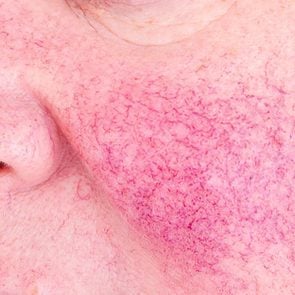What Causes Rosy Cheeks? What Skin Specialists Need You to Know
Updated: Nov. 27, 2020
There could be a medical reason for your red face or persistently pink cheeks.
Cheeks like roses
Rosy cheeks are usually considered a good thing: After all, don’t people apply blush to give themselves a pinkish glow? Drawing attention to the rosy hue of blood vessels beneath the skin’s surface signals youth, vitality—even sexual attraction.
“In romantic circumstances, a blush unveils our interest in the other person, and excitement can be contagious,” says Mary C. Lamia, PhD, a psychologist in Kentfield, California, and a professor at The Wright Institute.
We also think of a red face as jolly and happy, like Santa: “His cheeks were like roses, his nose like a cherry,” as the poem goes.
Unfortunately, though, rosy cheeks aren’t always a good thing. Temporary conditions like sunburn or windburn can be harmful to skin. And other medical causes for rosy cheeks could signal illness or a deeper problem.
If your redness isn’t going away, or is accompanied by other symptoms, see a dermatologist or general practitioner—it could be caused by one of these conditions. (Keep in mind that there are also other causes of facial redness or rosy cheeks including acne; eczema; alcohol; a reaction to medication, such as a niacin flush; or menopause-related hot flashes.)

Weather damage
Skin damage is easy to spot during the summer: If your cheeks are red and hot, you likely have a sunburn. But winter weather can also have its way with your skin, leading to skin damage—in other words, rosy cheeks—after a cold, dry, blustery day.
Doctors can’t say for sure what exactly “windburn” is, as it’s not a true medical condition. But, according to the Skin Cancer Foundation, it’s likely the result of wind irritating the top layers of the skin and causing it to slough off.
That shedding then leaves your newly exposed skin more vulnerable to the sun’s damaging UV rays. In addition to sunscreen, keeping your skin hydrated and moisturized can help protect it against the wind.
Most importantly, you want to make sure you don’t get frostbite, which occurs when parts of the body—usually those farthest from the core, including the cheeks, chin, nose, and ears—start to freeze. The affected area first turns red, then progresses to white or gray. If your cheeks get red or become painful, get inside and warm up as soon as possible. It’s important to treat frostbite right away.
Rosacea
One of the most common causes of rosy cheeks is a poorly understood yet common condition that affects 16 million Americans.
“Rosacea is an inflammatory condition that causes redness,” says Tanya Kormeili, MD, a board-certified dermatologist in Santa Monica, California. “Although the underlying reason is not very clear, we suspect a relationship to the tiny mite, Demodex folliculorum.” The Demodex mite lives on everyone’s skin, but has been found in higher numbers in people with rosacea.
Those with rosacea may also have a genetic predisposition for inflammatory reactions to other things in the environment, which cause the redness.
“We do know that a variety of factors trigger rosacea,” Dr. Kormeili says. “These include your genetics, hormones, stress, UV exposure, caffeine, alcohol, spicy foods, certain skincare products, as well as extreme temperature exposure.”
Symptoms of rosacea include acne-like bumps, as well as sudden flushing, general redness on your cheeks, and the appearance of broken capillaries. A dermatologist can distinguish rosacea from other conditions that look like it, and prescribe topical and oral medications. Your doctor may also recommend laser treatments to treat the dilated blood vessels that contribute to redness.
In addition, “mitigating the triggers is the best way you can fight rosacea,” Dr. Kormeili says. If you know spicy food makes the redness worse, for example, avoid it.
Allergies
Also called contact dermatitis, this is a skin reaction to something touching it.
“With contact dermatitis, the inflammation is caused by an outside insult,” says Lisa Anthony, MD, a dermatologist at Westmed Medical Group in Westchester, New York. Inflammatory symptoms on the cheeks can include a red rash that itches. Contact dermatitis can come on suddenly, as with poison ivy, or your skin can become sensitive to something, such as makeup, over a period of time.
“Contact dermatitis can be a cause of facial redness and irritation,” says Shaan Waqar, MD, an allergist/immunologist at ENT & Allergy Associates in Somerset, New Jersey. “Contact allergens such as fragrances and preservatives are common triggers in cosmetics and personal care products.”
Topical creams can help clear it up, and an allergist can test to see what you’re reacting to so you can avoid it in the future. A sudden rush of blood flow to the cheeks can also be a reaction to alcohol, spicy food, or certain medications.
Lupus
This chronic inflammatory disease causes joint pain—but also a telltale skin rash on the cheeks. “Lupus is an autoimmune condition in which your body attacks its own DNA molecules,” Dr. Kormeili says. “This condition can affect every organ in your body, including the skin. One of the manifestations of lupus is the classic ‘butterfly rash’ that spreads from cheek to cheek across the nose.”
The rash is caused by the immune system targeting the skin, leading to inflammation; the underlying reasons why some people get lupus aren’t really understood, though there’s likely a genetic component. About two-thirds of people with lupus have skin problems, which are often made worse by UV light like the sun.
A dermatologist may be the first one to spot lupus, and Dr. Anthony says a patient’s other symptoms help her pinpoint the diagnosis. “Facial redness in a butterfly distribution on the cheeks along with joint pain, photosensitivity, and family history of connective tissue disease is consistent with lupus,” she says.
If you’re diagnosed with lupus and have skin problems relating to it, a dermatologist may be part of the medical team that treats the disease, prescribing medications that can help clear your skin.
Fifth disease
This common childhood illness is nicknamed “slapped cheek” disease, and for good reason: The classic sign is redness in the cheeks that looks like you’ve been slapped.
Fifth disease—so called because it was fifth in a historical list of illnesses that caused rashes in children—is actually a virus.
“Facial redness in a young child with fever and viral symptoms is consistent with fifth disease, which is a mild rash caused by parvovirus B19,” Dr. Anthony says.
The lace-like rash, which is thought to be an immune system reaction, may spread from the cheeks to other parts of the body. Ironically, once it appears you’re no longer contagious; fifth disease is mainly spread like the common cold, through sneezes and coughs.
It’s usually not serious, unless you have a weakened immune system or are pregnant, and will go away on its own. As with other viruses, the best protection is washing your hands.
Scarlet fever
You may think scarlet fever is an old-time illness that Beth succumbed to in Little Women, and that no one gets it anymore. That’s often true, thanks to modern antibiotics that kill the strep throat-causing bug that also causes scarlet fever.
But scarlet fever still happens.
It’s even been making a comeback in England and parts of Asia, suggests a study published in 2018 in The Lancet. The disease, also known as scarlatina, is marked by a bright red rash on the body, as well as rosy cheeks with a pale area around the mouth
“Scarlet fever is caused by a bacterial infection—the bacteria that causes the illness makes a toxin that causes the rash,” says Jen Caudle, DO, a family physician and associate professor at Rowan University School of Osteopathic Medicine in Glassboro, New Jersey. “It typically has a rash that looks like a sunburn and is sandpaper-like. It often begins on the face or neck and can spread to the rest of the body, and can be bumpy.”
If often begins with a sore throat due to strep (a type of bacteria called Streptococcus pyogenes or Group A strep), which can be quickly picked up with a throat swab and a rapid strep test at the doctor’s office. Strep throat and scarlet fever can be easily treated with antibiotics, preventing the spread of the bacteria in the body.
It’s especially important to take all of the medication, as an untreated infection can lead to more serious complications. It’s rare, but strep infections can lead to rheumatic fever, which can cause permanent damage to the heart valves and lead to heart failure.
As with cold and flu, stopping the spread of the highly contagious strep bacteria involves good hygiene and handwashing.




















